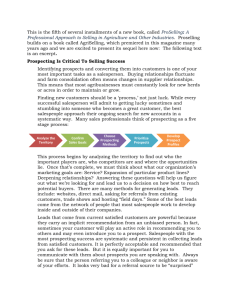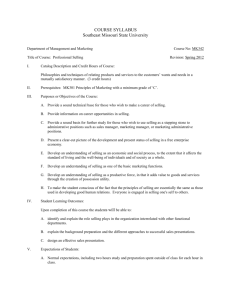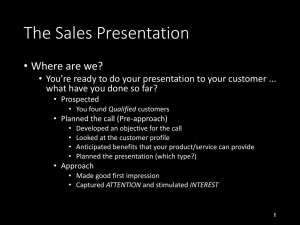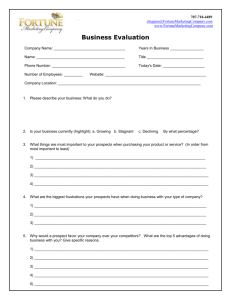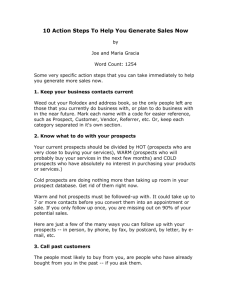Personal Selling: Preparation and Process
advertisement
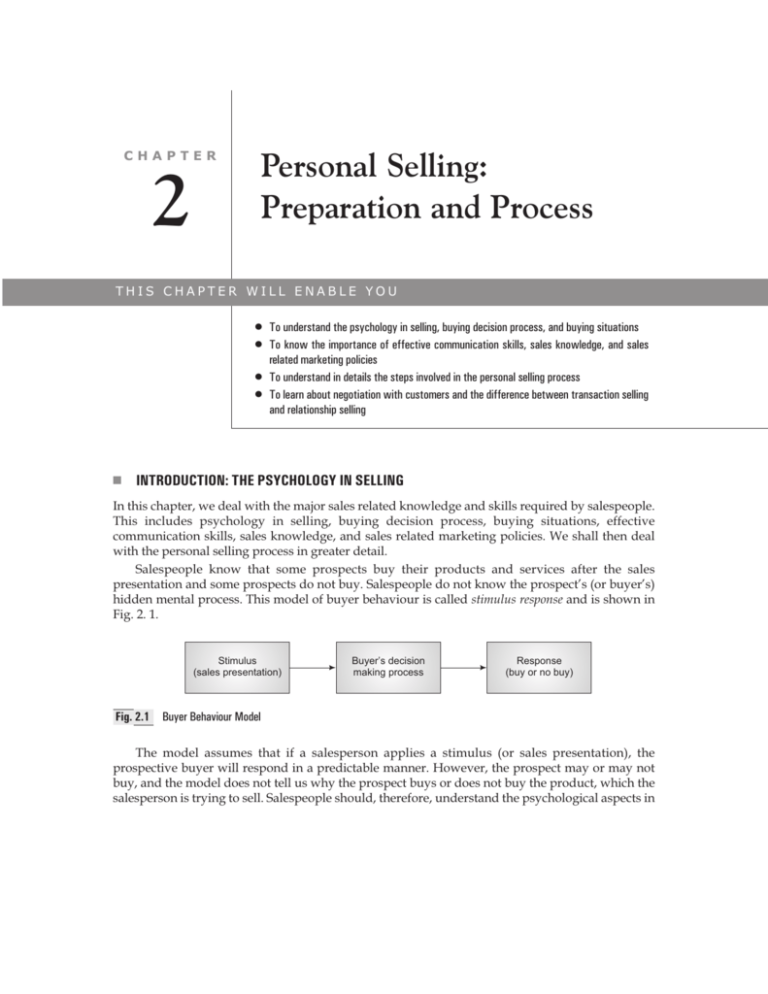
+0)26-4 Personal Selling: Preparation and Process 2 THIS CHAPTER WILL ENABLE YOU To understand the psychology in selling, buying decision process, and buying situations To know the importance of effective communication skills, sales knowledge, and sales related marketing policies To understand in details the steps involved in the personal selling process To learn about negotiation with customers and the difference between transaction selling and relationship selling INTRODUCTION: THE PSYCHOLOGY IN SELLING In this chapter, we deal with the major sales related knowledge and skills required by salespeople. This includes psychology in selling, buying decision process, buying situations, effective communication skills, sales knowledge, and sales related marketing policies. We shall then deal with the personal selling process in greater detail. Salespeople know that some prospects buy their products and services after the sales presentation and some prospects do not buy. Salespeople do not know the prospects (or buyers) hidden mental process. This model of buyer behaviour is called stimulus response and is shown in Fig. 2. 1. Stimulus (sales presentation) Fig. 2.1 Buyer’s decision making process Response (buy or no buy) Buyer Behaviour Model The model assumes that if a salesperson applies a stimulus (or sales presentation), the prospective buyer will respond in a predictable manner. However, the prospect may or may not buy, and the model does not tell us why the prospect buys or does not buy the product, which the salesperson is trying to sell. Salespeople should, therefore, understand the psychological aspects in 2.2 Sales and Distribution Management buyer behaviour. Psychological factors of buyer or consumer behaviour includes attitudes, perceptions, motivations, and personality of buyers. Study of consumer behaviour helps the salesperson to understand the psychological aspects in selling or why the prospect is buying or not buying the product or service. BUYING DECISION PROCESS Salespeople must understand that household and individual consumers as well as business (or industrial) buyers pass through certain stages or steps in buying a product. In consumer markets, individual and household consumers make buying decisions based on five mental stages of buying process, as shown in Fig. 2.21. These are: (a) problem (or need) recognition, (b) information search (or collection), (c) evaluation of alternatives, (d) purchase decision, and (e) post purchase behaviour. Problem/ need recognition Fig. 2.2 Information search/ collection Evaluation of alternatives Purchase decision Postpurchase behaviour FiveStage Model of the Consumer Buying Process Problem (or need) Recognition The consumer buying process starts when the prospective consumer recognises a problem or need. The need can be caused by internal or external stimuli. The internal stimulus could be physiological like hunger or thirst, or psychological like desire for the prestige of owning a Skoda car. The external stimulus may be for a person who sees a fresh pizza at Pizza Hut that stimulates his hunger. Whatever may be the cause of the need, the salesperson must identify the buyers needs to know what information about the product benefits should be given so as to satisfy the buyers needs. Information Search (or Collection) An aroused consumer will search for more information. For low involvement products (like bread, butter, and biscuit), which are purchased routinely, the information search may be milder such as a person becoming more receptive to information about a product. However, for high involvement products such as a home, an automobile, or insurance, which requires more of an investment in time and money, the person may want an active information search. This involves visiting retail stores, asking family members and friends, and talking to salespeople about a products price, benefits, sizes or models, warranty service, and so on. Evaluation of Alternatives There is no single evaluation process used by all consumers, or by one consumer in all buying situations. We must understand the following factors in the evaluation process used by consumers mostly on a rational basis: The consumer is trying to satisfy a need, or solve a problem. The consumer is looking for certain advantages or benefits from the product or service that satisfies the need or solves his/her problem. Personal Selling: Preparation and Process 2.9 customer satisfaction and sales performance. Customer service can be pre-sales, during-sales, or post-sales and it depends on the type of product and service offered. Warranty (or guarantee) policy is relevant to certain products like automobiles, and photocopiers. THE SALES PROCESS Salespeople perform many activities which can be broadly grouped into selling activities, and nonselling activities. The selling activities consist of the various steps of the selling process. The nonselling activities include preparation of sales reports, collecting payments, obtaining market information, travelling and waiting to see customers. There is no magic formula to make a sale. However, it is widely believed that if a salesperson follows the steps shown in Fig. 2.3, the chances of success are greatly improved. The steps or the phases may not occur in the same sequence or order that is shown. Customers may raise objections during a sales presentation and trial close may be attempted after the presentation, if the customers interest is high. Similarly, the customer may or may not start the negotiation, after a presentation. The sales process is a recommended set of phases or steps that works better than any other process in certain situations. Let us discuss each of the steps. Prospecting and Qualifying Preapproach (Precall Planning) Approach Presentation and Demonstration Overcoming Objections Trial Close/Closing the Sale Follow-up and Service Fig. 2.3 The Personal Selling Process Prospecting A prospect is an individual, a family, or an organisation who needs the product or the service a salesperson is selling and also has the ability to buy. A prospect is not the same as a sales lead or a lead. A sales lead generates the name of a person or a business firm that is a probable prospect. 2.10 Sales and Distribution Management Once it is found that the sales lead wants the product and has the ability to buy, the sales lead becomes a prospect or a potential customer. It is an important activity for succeeding in todays competitive environment. To increase or even maintain sales volume, particularly if the sales from the existing customers is stagnating or declining, a company must continuously prospect for new customers. Earlier most organisations had left it to their salespeople to find leads. Now more companies are taking the responsibility of searching and qualifying the leads. This enables salespersons to use their expensive time on selling activities. Organisations can generate leads (or obtain names and addresses of probable prospects) in a number of ways, as shown in Table 2.2. Table 2.2 Prospecting/Lead Generating Methods Sl. No. Prospecting Method Brief Description 1. Referrals from existing customers 2. Referrals from internal company sources 3. Referrals from external sources 4. Networking by salespersons 5. 6. Industrial directories Cold canvassing Requesting existing customers to suggest the names of prospects. This is a convincing source 3 of nearly two thirds of total leads. Company advertising, direct mail, website, trade shows, and teleprospecting activities. Suppliers, intermediaries, bankers, trade associations, commercial dotcom vendors. Salespersons become members of civic/social organisations like Lions Club, Bangalore Club, and Rotary Club to meet new people who may be prospects or may provide leads. Yellow pages published by government and private publishers. Unannounced calls by salespeople on firms that may need the product/service the salesperson sells. Costly and time consuming. Used for widely needed products like office supplies. Qualifying It is important that the lead, or the probable prospect is qualified (to meet the necessary standards or conditions to receive further attention). The necessary conditions for the probable prospect or the lead to get qualified to the prospect or potential customer are: The probable prospect has a need for the product/service being sold. The probable prospect (could be an individual, a family, or an organisation) can afford (or has an ability) to buy the product or the service. Most companies contact the leads by phone or mail to find out their level of interest and financial capacity. Traditionally, the salespersons were expected to contact the leads or probable prospects. Today, the marketing department in many companies undertake the tasks of prospecting and qualifying. The prospects, after qualifying, are placed in three groups: hot prospects, warm prospects, and cool prospects. Hot prospects These prospects have good requirements of the companys products/ services and are financially sound. Such prospects are handed over to the companys salespersons to convert them to the companys customers. Warm prospects This group of prospects have medium or average requirements of the companys products/services and are financially sound. These prospects are given to the companys telemarketing team for follow-ups. 2.22 Sales and Distribution Management Fig. 2.5 Steps to be Followed by the Salespersons Asks questions Some of the questions the prospect may ask are: When can you deliver this product? or What is the price? or What are your payment terms? Some times, the salesperson asks another question in response to the prospects buying signal question in order to better understand the prospects needs or thoughts, such as When do you want the delivery?, How much quantity is required?, or What payment terms you want? Becomes friendly The prospect becomes friendly, once he mentally decides to buy. The anxiety or pressure of buying changes into relaxation. An ability to understand the prospects buying signals correctly helps a salesperson decide when and how to close the sale. Although most of the time, the time to close the sale is after the presentation, it can also happen after trial close, during presentation, or after answering the objection. It is important for a salesperson to remember that when he/she asks for the order, he should remain quiet and not say anything. If the salesperson says something after asking for the order, the pressure on the prospect to make a decision goes off, and may result in losing the sale. Closing techniques There are many closing techniques. Some of the closing techniques are discussed below: Alternative choice close In this technique, the prospect is given a choice between two or more items or models, and not between buying or not buying. For instance, Which of the three models do you prefer? By giving a choice, either the salesperson gets a yes, I prefer this model, or some kind of objections, which if satisfactorily handled, would enable to come closer to making the sale. This technique is effective if used correctly. Minor points close This technique is similar to the alternative choice close, discussed above. It is sometimes easier for a prospect to decide on many minor points than to make a bigger decision on whether to buy or not to buy. By having the prospect make decisions on a products minor points, the salesperson can cleverly lead into the decision to buy. For example, the salesperson may ask questions in quick succession, If you buy this solar heater, Which model would you prefer?, How soon would you like it to be delivered?, or Would you like to pay on installment basis? With these kinds of minor point questions, the prospect typically develops a positive inclination towards buying the product. 2.28 Sales and Distribution Management He should stress on the consequences of a failure to resolve the issue. The purpose here is to move the other party from win-lose style to winwin style. It may be difficult to remember the above points and how to use them. The solution to this difficulty is to practice. By practising these points in role-playing excercises, negotiating skills can be improved. TRANSACTIONAL AND RELATIONSHIP SELLING Relationship selling is different from the traditional transactional selling. These difference are shown in Table 2.6. Table 2.6 Difference Between Transactional and Relationship Selling Parameters Transactional selling Relationship selling Objective Focus Get the order or sales Sales presentation, overcoming objections, and closing Many customers with low profit potential Become sole or preferred supplier Building trust and superior customer service Customer type and numbers Length of relationship Sales team Short (days) One or two junior level sales people Selling efforts Pricing Strategy Low to medium, involving few functions Competitive or lowest prices to get sales Few high-profit potential customers Long (months/years) Team selling with three to five junior and senior level people High, involving many functions Mutually acceptable prices for profits or mutual benefits Transactional Selling (or Exchanges) These are mostly one-time-only exchanges with an objective of getting sales or orders from customers whose profit potentials are low. The selling efforts are minimum, with low or competitive prices and/or availability as main criteria for getting sales. There is little interest by either the buyer or the seller to extend the relationship. Sellers of office supplies like stationary materials and cleaning chemicals are some of the examples of transactional selling. Relationship Selling The objective of relationship selling (also referred to as partnering or collaborative relationship) is to become the sole or preferred supplier. This objective is achieved by building a strong social, economic, service, and technical ties over a long period of time. The foundation of this relationship is trust and commitment. Both the partners (the buyer and the seller) accept that the relationship is so important that it deserves maximum efforts to continue with it. This is done by joint problem solving and multiple connections in order to integrate the processes of the two companies. The examples of relationship selling (or partnering relationship) are seen in automobile and software industries. Personal Selling: Preparation and Process 2.29 Value-added Selling For customers whose sales and profit potential are medium, or customers whose purchase orientations are procurement type (seeking quality improvement and cost reduction, but not partnering relationship), value added exchanges or selling strategy is used by some selling organisations. The focus is on complete understanding of the present and future needs of the customer, and meeting those needs better than competitors, so as to obtain a maximum share of the customers business. Summary In this chapter, we dealt with major sales related knowledge and skills required by salespeople. This includes psychology of selling, buying decision process, buying situations, effective communication skills, sales knowledge, sales related marketing policies as well as personal selling process in greater detail. To understand the psychological aspects of buying or not buying, the salesperson must study the consumer behaviour, which includes various factors like attitudes, perceptions, motivations and personality of buyers. Salesperson must also understand that household and individual consumers make buying decisions based on five mental stages of buying process, such as problem (or need) recognition, information search (or collection), evaluation of alternatives, purchase decision, and post-purchase behaviour. In case of business buyers, the buying decision process includes three additional stages (or steps), over and above the five stages mentioned earlier for consumers. These three additional stages are: determination of characteristics and quantity of needed product or service, development of product/service specifications, and obtaining and analysing supplier proposals. Salespeople must also find out the buying situations of household and individual consumers, which include routine, limited and extensive decision making. For business buyers, the buying situations consist of new task, modified rebuy, and straight rebuy. Effective communication in a sales situation includes transmission of verbal and non-verbal information between a salesperson and a buyer. The salesperson should also get knowledge of the company, products, customers, and competitors. Both salespeople and sales managers (or executives) should understand sales related marketing policies such as pricing, distribution, promotional, and product. The selling activities of salespeople consists of various steps of selling process. These are: prospecting and qualifying, preapproach, approach, presentation and demonstration, overcoming objections, trial close (or closing the sale), and follow-up and service. These steps are discussed in great detail. Finally, a salesperson should understand the difference between transactional and relationship selling. Glossary of Key Terms 1. AIDA approach It is a sales presentation method, which uses a structured and well known formula or steps, called AIDA, meaning attention, interest, desire, and action. A salesperson takes the buyer through these mental states in the buying process. 2. Approach It is one of the steps of the selling process in which the salesperson meets with the buyer for the first time. 3. Canned sales presentation It is one of the methods of sales presentations, in which the salesperson makes a prepared or memorised sales presentation. It is also referred to as stimulus response method. Personal Selling: Preparation and Process 2.31 Conceptual Questions 1. Why should the salespeople must understand the psychological aspects of selling and buying decision process ? 2. How the buying situations of household consumers are different from those of business buyers? 3. How the knowledge of sales related marketing policies is helpful to the salesperson to perform on-the-job effectively ? 4. What is the difference between a prospect, suspect, and sales lead? How the probable prospects are qualified? 5. In what manner the approach step is different than the preapproach step? Describe briefly different approach techniques used by salespeople. 6. How salespeople understand prospects needs? 7. What are the different sales presentation methods and how are they matched to different sales situations ? 8. Explain the difference between a trial close and a close. 9. Describe the methods used for handling and overcoming sales objections. 10. Discuss why a salespersons job is not over even after getting an order. Objective Type Questions Select the most appropriate out of the various alternatives given in each of the following questions. 1. The first stage in buying decision process, in both consumer and business markets, is: (a) information search, (b) deciding the characteristics and quality of needed product, (c) problem or need recognition, or (d) none of the above. 2. Buying situations for business or industrial buyers are new purchase, modified rebuy, and one of the following: (a) routine purchase, (b) straight rebuy, (c) limited purchase, or (d) extensive purchase. 3. The major components or tools of a companys promotional efforts are advertising, sales promotion, public relations and publicity, personal selling, and one of the following: (a) direct marketing, (b) distribution channels, (c) marketing logistics, or (d) supply chain management. 4. A prospect who needs the product and has an ability to buy, is also referred to as a (a) suspect, (b) sales lead, (c) probable prospect, or (d) potential customer. 5. Some of the commonly used methods of sales presentation are stimulus response, formula or formulated, team selling, consultative or problem-solving, and one of the following: (a) question, (b) product, (c) praise or (d) need satisfaction. 6. The legend for AIDA formula includes attention, interest, desire, and one of the following: (a) arrangement, (b) agreement, (c) action, or (d) assistance. 7. The legend for FAB approach consists of features, advantages, and one of the following: (a) betterment, (b) basics, (c) bargaining or (d) benefits.

